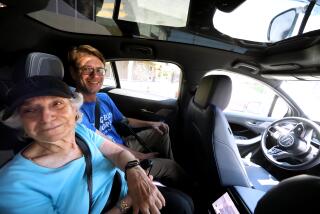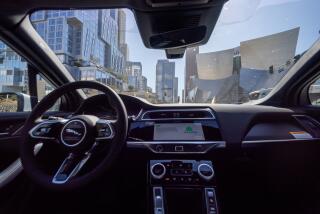The Cutting Edge: COMPUTING / TECHNOLOGY / INNOVATION : Next for Robots: Putting Them Literally at Our Beck and Call
Humans frequently use their hands to communicate. They point when giving directions, hold up a hand to mean âstop,â and gesture to say âcome here.â Even non-humans such as dogs can be trained to respond to hand signals. But can robots or automobiles? Thatâs the question researchers at the University of Rochester and at UC San Diego are trying to answer in separate research projects. At the University of Rochester, graduate student Polly Pook has so far guided a robot in opening a door and flipping a plastic fried egg by using hand motions. To detect the hand motion, the robot relies not on its eyes, but rather on sensors mounted on a special glove that Pook wears. This approach, called tele-assistance, provides a middle ground between totally autonomous robots that lack the judgment and common sense of a human, and robots whose every motion is guided by a human.
Tele-assistance provides the robot with just a few strategic cues from the human operator which, in conjunction with a little programming, allow the robot to function autonomously. Opening a door might not sound tough, but a robot is easily confused unless it knows what kind of handle the door has. But when Pook points to the door and shapes her hand to indicate the type of handle, the robotâs pre-defined program can take over. Possible applications for hand-controlled robots include robot assistants for the elderly and disabled, mining exploration of remote sites and hazardous waste cleanup.
At UC San Diego, a team of researchers at the Visual Computing Lab has developed a robot vehicle that can be controlled remotely by hand gestures. The teamâs gesture-driven robotic vehicle, called ROBOGEST, is the result of two ongoing projects: autonomous vehicle navigation and gesture interpretation for a computer-human interface.
To control the vehicle, the operator displays specific hand gestures to a video camera mounted on the lab computer. Each gesture represents a specific set of instructions, such as âaccelerateâ or âbrake.â The computer interprets the hand motions and sends the correct instructions over a radio link to a computer on the vehicle. This computer, in turn, controls the vehicleâs motion. Currently, the system can understand six single gestures but has the capacity to learn many more.
*
Better Bones: Currently, bone grafts require the patient to sacrifice bone from some other part of his body, or rely on bone from someone else, risking incompatibility and disease transmission. But a bone graft material developed at Massachusetts Institute of Technology could improve surgical procedures for patients who have suffered bone damage. The material consists of a calcium phosphate ceramic and a biodegradable polymer in the form of tiny spheres. These spheres act as scaffolding for the growth of new bone. Over time, they degrade and are excreted, and the holes they leave give the graft the same porous structure as natural bone. This structure allows new cells to grow within the holes. Prime candidates for the procedure are patients who have suffered a tumor or a fracture that leaves a gap in the bone, as well as those who have artificial joints that are wearing out.
*
Back-Yard Offices: More and more workers are trying to carve out office space in their basements, garages and family rooms. In response to this changing definition of what constitutes a âworkplace,â students at Art Center College of Design in Pasadena are developing designs for small, self-contained, movable home offices that could be set up in the back yard. The project is being sponsored by Huntington Beach-based Tetrahex Corp., which is looking for new ways to use the strong, lightweight plastic panels it produces for the aerospace industry.
While the Tetrahex panels have thus far been used mainly in highly specialized applications such as solid rocket fuel supports and space vehicles, the company believes that the technology could have much broader uses in athletic equipment, soundproofing, and electric car construction. But Art Center students will use them to create lightweight, easy-to-assemble office pods capable of accommodating a work surface, computers, storage, lighting and seating. Could it be that one day start-up companies wonât have their origins in garages, but in pods?






